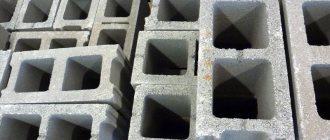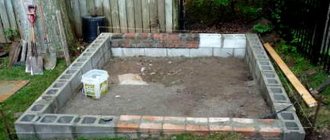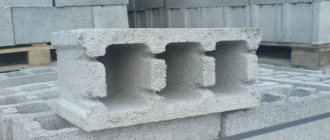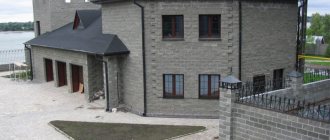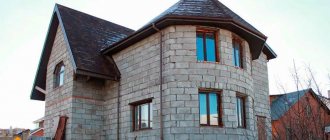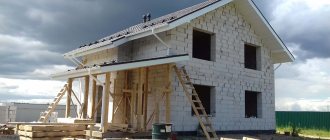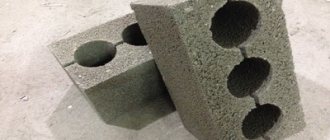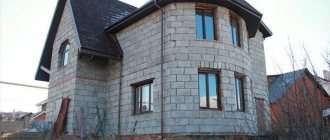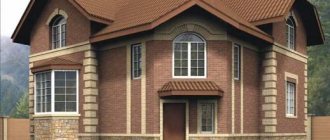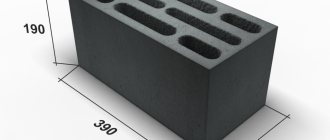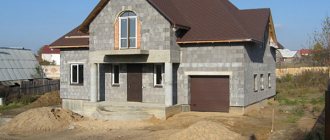Any reasonable person and prudent owner, before building a house from cinder blocks, carefully studies the advantages of this building material, its physical and mechanical characteristics, thereby choosing the most optimal type of wall blocks.
Low price, ease of installation and the ability to make the material yourself, about thirty years ago made cinder block popular with both individual and large developers. But from those times to this day, there has been an opinion among people that building a house from cinder blocks is dangerous to health. This is partly due to the fact that previously “available” material was used as filler in wall blocks: blast furnace slag, which was desperately “fouling”, and solid waste from industrial enterprises.
We build a house from cinder block - we save time and money
Blast furnace slag gives the name to the wall blocks
However, as the population’s well-being grew and the market became saturated with new, modern building materials, the construction of cinder block houses has not lost its relevance, because technological progress has also affected this simple product.
Where are they used?
Slag concrete products have gained popularity among industrial and private developers. The installation location and the tasks to be solved determine the set of properties imparted. The characteristics of cinder blocks determine the proportions and composition of the components. The house can have a foundation and all walls made of cinder blocks. Product modifications make it possible to form external load-bearing and non-load-bearing walls, partitions, opening lintels, chimneys and gas ducts, etc. Products can also form stiffening belts. When using internal reinforcement, floor slabs can be made entirely of slag concrete.
Return to contents
Cinder block manufacturing technology, cinder block size and other characteristics
Let's define what a cinder block is. Cinder block is an artificial building stone obtained by pouring and pressing a mixture of cement and slag. In the production of cinder blocks, relatively inexpensive material is used, which affects the final cost.
Main characteristics of cinder blocks (valid for industrial products)
- Standard cinder block size: 188×199×399 mm. (according to GOST 6433-99 “Concrete wall stones”)
- Thermal conductivity: from 0.27 to 0.65 W/m3
- Density: from 750 to 1450 kg/m3.
Compound
Slag concrete blocks contain aged slag of certain fractions. The grain size of slag sand is a parameter that determines the properties of slag concrete products. The binding components are mainly cement and lime. For the solution, clean water or specially acidified water is used. Known material formulations require, in addition to slag, the use of cement, brick and concrete chips, crushed stone screenings, ash, volcanic perlite, sand, expanded clay, etc.
Reduced thermal conductivity of products is given by pine needles and sawdust. Reducing the size of stone-like fillers gives the blocks high strength and additional weight. However, low thermal conductivity and mass are achieved by using larger fractions. Thus, the characteristics of granulated slag are decisive.
Slag-alkaline concrete has a special composition. The mixture includes ground sand slag, selected alkaline solution, large and small aggregates. Lightweight slag-alkaline concrete is created on the basis of blast furnace granulated slag or expanded clay. At the same time, the mixture contains room for agloporite, pumice, limestone (shell rock), and wood waste.
Return to contents
Competent opinion of specialists
- Those who used cinder blocks for construction were satisfied with the performance characteristics of the material. First of all, I like the fact that it does not crumble or crumble. And secondly, it maintains a comfortable indoor temperature.
- If a house is built in a region with low seismic activity, it will serve its owners for more than 70 years. With high-quality interior and exterior finishing, the building will not get wet, which means mold and unpleasant odors will not appear.
- There is a category of people who claim that living in cinder block houses is harmful to health due to increased background radiation. If foreign impurities are included in the mixture, this will lead to bronchial asthma and allergies. This is possible if the house is built from a cheap fake that does not meet quality standards.
- Among the disadvantages of using cinder blocks is the need for additional costs for finishing materials. If you skimp on finishing, this will lead to the blocks getting wet, freezing and cracking. But all these troubles can be avoided if you use high-quality material, erect buildings in accordance with building codes and adhere to planned calculations.
A cinder block house that was built 2 years ago
Stamps
The specific proportion of the components of the material forms its characteristics - the grade of the block. The strength of products is one of the main parameters. The bearing capacity of slag concrete blocks is set from M10 to M125 (kg/cm2). Cinder blocks with M100 and M125 are laid in the foundation; they will also support the house.
M25, M35 are used in non-load-bearing walls. Load-bearing walls are erected in blocks of M50 or more. It is advisable to insulate the house with products with strength M10. Thermal conductivity is linked to the strength grades of products.
Thus, for a material density of 1050-1200 kg/m3, thermal conductivity indicators are in the range of 0.35 – 0.48 W/(m °C). Slag-alkaline concrete has other established grades of strength (from B10 to B110), moisture resistance, frost resistance, etc., obtained due to significant differences in production technology. The thermal conductivity of such a material can be very low - within tolerances of 0.059 - 0.13 W/(m °C), it is more effective to insulate a house with just such blocks.
Return to contents
Pouring cinder block
- before filling the molds with solution, their walls must be lubricated with grease or soapy water
— after preparing the slag concrete mortar and forms, we proceed to filling them with the finished mortar. The molds must be filled with the solution evenly to the brim.
- glass bottles can be used as a means to create internal voids in the block. We stick bottles into the molds with the solution, neck up, remove excess solution and level the surface again. After about 5 hours, the bottles will need to be pulled out, otherwise, after the solution has completely hardened, they will not be able to be removed whole.
- a day or three after pouring, carefully remove the cinder blocks from the molds and lay them out on a dry horizontal surface and cover them with plastic wrap so that the material does not receive additional moisture from precipitation. The most suitable conditions for drying cinder blocks are from +20 to +25°C. We leave the cinder blocks in this state for 1 month until they fully gain strength.
After one month, new cinder blocks can be used for masonry.
In the next section below, we will not present the advantages and disadvantages of a house made of cinder blocks, relying on the specific features of cinder block as a separate building material and its convenience in construction, without linking it with other building materials into a single structure - a residential building, as most authors of publications on this topic do , but we will present the real pros and cons of a ready-made residential building whose walls are made of cinder blocks, which the owner encounters while actually living in such a house.
The pros and cons of a cinder block house are listed below, taking into account the fact that the house was built in compliance with the technology and the cinder block as the main material for the walls was also of proper quality. If the construction technology is not followed, as well as if defective material is used, in principle, as when building a house from any material, then problems during the operation of such a house can be unpredictable and significant.
cinder block house without facade finishing
Manufacturing methods
Forms are used (including without a bottom), in which the material gains the primary strength of the stone. The initial mechanical properties are given to it by vibration pressing, pressing and molding. The main goal is to compact the formed mass evenly and quickly. At large enterprises, these operations are automated and technologically combined with appropriate equipment.
Return to contents
Pressing
The mass of material loaded into durable dies is compacted by mechanical pressure. Press equipment develops a force of the order of several tons. The operation is uniform in the manufacture of both monolithic and hollow products.
Return to contents
Vibration pressing
The moving mixture in the molds is compacted in the vibrocompression area. The operation creates conditions for the mass to maintain the acquired spatial form before being released from the matrices. The duration of the process is 20 – 30 seconds. and can be increased to one and a half minutes (for equipment without intensive pressing). The shaking frequency is about 50 Hz. In less equipped industries, vibrating tables and manual surface electric vibrators are used.
Return to contents
Molding
It can be manual or automated, involving the use of wooden, polyurethane and steel matrices, which can have various designs, including multi-cell ones, for filling with a mixture. The surfaces of the molds are coated with lubricant. For decorative products (for example, to create a “chipped brick” facial texture), the plaster mass is leveled at the bottom.
Then a slag concrete mixture is poured into the matrix up to half the depth and compacted. Next, void formers are introduced into the mold and filled to the edge of the mold with the remaining mixture. The mold is subjected to vibration and pressing. The outer surface of the products is created last. High-quality stones released from molds have a dense solid body and a regular, stable shape along the edges and edges.
Return to contents
Application of lightweight concrete
The most affordable is concrete with slag filler. As you know, slag is a by-product that is formed during the production of metal and during the combustion of coal, as well as anthracite. Depending on the purpose of concrete, they resort to adding slags of various origins. For example, metallurgical slags are used for load-bearing walls, which increase their strength, and fuel slags are used for internal walls, which improve thermal insulation. Also, to improve the properties of slag concrete, it is necessary to achieve an optimal granulometric composition, for which the slag is sifted through special sieves, first large, with a cell size of 40X40mm, and then small ones of 5X5mm. The ratio of large and small particles in concrete directly affects its strength and thermal insulation characteristics - so when using large slag, the concrete turns out to be light with good thermal insulation, but less durable, and when using small slag, on the contrary, it is more durable, but with less thermal insulation. To construct load-bearing walls, the ratio of fine to coarse slag must be at least 3:7. Also, to increase the strength of the walls, 20% of sand is added from the total mass of slag, and for plasticity, 3-5% of clay or lime dough is added. In monolithic walls made of slag concrete, when pouring, you can create voids and insert liners from less dense materials (wood, foam plastic, polyurethane, paper), which improve the heat-insulating properties of the walls, reduce concrete consumption, but reduce their strength characteristics. Slag concrete is marked with numbers that characterize its strength. Thus, grade 10 is designed for a load of 10 kg/cm2 and is manufactured in the following proportions:
- cement grade 200 – 1 part,
- slag - 15 parts, of which fine - 5, large - 10 and is used exclusively as insulation.
Grade 25, with a design load of 25 kg/cm2, has the following proportions:
- For 1 part of cement grade 200 there are 8 parts of slag (fine - 3, large - 5) and is used for the construction of internal walls.
The most durable grade 50 is necessary for load-bearing walls, which is made based on the proportions:
- 1 part of cement grade 400 and 8 parts of slag, moreover, in equal proportions of large and small, 4 parts each, and can withstand a load of 50 kg/cm2, respectively.
When constructing walls made of lightweight concrete, formwork is used, made of boards treated with water-repellent compounds and lined on the inside with metal, roofing felt or synthetic film. As the walls are poured with concrete, the formwork is moved higher and secured using steel studs with threads for nuts 50-70 mm long. on each side or to fixed posts installed every 1.5 meters along the walls poured with concrete. After 3 days after pouring, the concrete gains strength and the formwork is removed or moved higher.
Varieties
In the construction industry, it is customary to divide cinder blocks depending on the degree of emptiness of the internal volume into solid and hollow. Air can occupy up to 40% of the stone's size.
Return to contents
Full-bodied
The strength grade determines whether the product should be hollow or solid. The foundation and supporting structures are formed only from solid stones. However, wall and partition stones can be either the first or the second.
Return to contents
Hollow
Products vary in the number and size of internal voids. The shape of the cavities plays a significant role. Holes in the body of the stone are created through and blind. The latter allow you to save masonry mortar. Products with rectangular voids can be easily broken evenly.
At the same time, round and oval air cavities create additional strength. Products whose volume is 40% filled with air have acceptable thermal conductivity. However, reducing the volume of cavities by up to 30% with a slight deterioration in thermal insulation properties significantly increases the strength of the stone.
Return to contents
How many cinder blocks in a cube
With these dimensions, 3×5 = 15 blocks will fit in one row on a pallet.
It is known that the weight of a hollow cinder block is 13 kilograms, and a solid one is 20 kilograms. From this value it can be determined that the mass of one row of products will be 15 × 13 = 195 kg. Taking this value into account, you can find out that the maximum number of rows on a pallet will be no more than five 1000/195 = 5, so in one pallet there will be 5 × 15 = 75 pieces of such cinder blocks.
Now let's deal with solid blocks. As we have already said, the mass of such a product corresponds to 20 kilograms, so one row will weigh 15 × 20 = 300 kilograms. This means that you can lay no more than three rows of such products, which is 3×15 = 45 pieces of cinder blocks in a pallet.
Home » Materials for the garden.
By purpose
The standard dimensions and purpose of the stone are linked. Full wall blocks and half-blocks are a standard range of standard sizes. Their functional purpose: ordinary (in masonry) and front. The latter are stronger and more durable.
Return to contents
Full wall block
The product is manufactured both solid and hollow. The standard dimensions of one unit are 390x190x188 mm.
Return to contents
Wall semi-block - hollow
The product is smaller in size compared to a full wall block. Available only in a hollow version. The product unit is available in two sizes: 390×120×188 mm and 390×90×188 mm.
Return to contents
Septal
Only one standard size of wall semi-block is used for the intended purpose - 390X120X188. The realized masonry thickness is 120 mm, which is similar to the width of the walls when they are built using standard bricks.
Return to contents
Decorative wall half-blocks and blocks
The products are cast in special molds, the bottom of which forms a textured pattern (“broken brick”, “wild stone”, etc.) on the front side of the products. They may have structural grooves that increase the convenience of masonry. The products look original in the masonry of fences. Their composition includes dyes that have high moisture resistance.
Return to contents
How to calculate the amount of cinder block?
After this, the cube is converted to the selected value and divided by the resulting volume of material.
1 m3 = 1000000 cm3 or 1000000000 mm3, then let’s look at a specific example. A cinder block for load-bearing walls of a standard size has the following parameters: 390 millimeters for length, 190 millimeters for width and height. First, let's determine the volume of one block 390 × 190 × 190 = 14079000 mm3. Now let’s see how many such products we get in one cube: 1000000000/14079000 = 71 pieces, and the result will be the same regardless of the units of measurement taken.
Next, we determine the number of partition blocks per cubic volume. It should be noted that such products have a standard size of 39 centimeters in length, 12 cm in width and 19 cm in height. Let's try to calculate differently, taking the value of cinder blocks in centimeters. As in the previous example, we calculate the volume of one product 12 × 19 × 39 = 8892 cubic meters. centimeter Now let’s find out how many of these cinder blocks will fit in one cube with a volume of 1000000/8892 = 112 pieces.
When purchasing any wall materials, you need to take 5-10 percent more. This is due to the possible destruction of the blocks during transportation, as well as loading or unloading. It should be noted that in cinder concrete masonry, a certain volume of the wall will be spent on installing mortar joints, therefore, in one cube of the assembled wall there are slightly fewer blocks than the calculated one, although this number can not be taken into account.
Advantages and disadvantages
One of the advantages is ease of installation.
Advantages of the stone:
- Almost the lowest cost compared to materials for similar purposes.
- Possibility of casting stone with any specified properties.
- Cinder blocks have proven themselves when installed in the foundations of structures.
- Wall modifications reduce the load on the base and the structure as a whole, and have good sound insulation properties.
- The increased size of stone units reduces construction time and costs.
- Easy to install.
- Duration of operation - tens of years.
Disadvantages of the product:
- The thermal insulation properties of products are not anisotropic.
- The settled stone retains its performance even under intense exposure to moisture. However, full strength gains occur after 1 year, which requires proper care after installation.
- The thermal conductivity of cinder blocks used in exterior walls is too high.
Return to contents
How to make the right choice
What should you pay attention to when purchasing piece cinder block stone? You need to use the services of certified manufacturers. This approach can most fully guarantee the high quality of building materials.
It is also necessary to inquire about the exact composition of the original ingredients and the environmental certificate of suitability for use in residential construction.
It is advisable to familiarize yourself with laboratory test reports and find out strength characteristics such as frost resistance, weather resistance, and water resistance.
An external inspection is required. The product must have the shape of a regular parallelepiped. The dimensions of the edges should not differ by more than 1...2 mm, both on one stone and on any other randomly selected from the proposed batch. Concrete on external surfaces must be smooth, without signs of looseness or imperfection. The voids must be symmetrical and in no case connected to external planes in the form of cavities.
